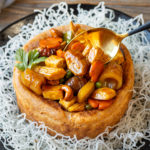Taro Basket or Prosperity Yam Ring - (芋钵Yù bō or 佛钵 Fú bō)
This vegan Taro Basket or Prosperity Yam Ring is a must-have dish at wedding banquets or celebrations. The crispy taro basket is filled with a delicious Kung Pao vegetables stir-fry and served on top of a bed of crispy noodles. This appealing dish is sure a crowd pleaser for parties or potlucks.
Servings: 6 people
Ingredients
Taro Basket
- 250 g taro
- 50 g wheat starch plus more for dusting
- 3 tablespoon hot boiling water or more
- ½ teaspoon salt
- 1 teaspoon sugar
- ¼ teaspoon 5-spice powder
- 25 g coconut oil
Filling
- 2 garlic cloves
- 3 dried chili
- 1 small carrot sliced
- 3 oz tofu cubed
- 3 oz King Oyster mushrooms sliced
- 3 oz Konnyaku sliced
- ¼ cup baby corn
- 3 tablespoons frozen peas
- 3 tablespoons roasted chestnut
- 3 tablespoons toasted cashew
Sauce
- 1 tablespoon ShaoXing cooking wine
- 1 tablespoon soy sauce
- 1 tablespoon dark soy sauce
- 1 tablespoon vegan oyster sauce
- 1 teaspoon sugar
- 2 teaspoons corn starch
- ½ cup water
Other Ingredient
- 1 oz dried mung bean vermicelli
Instructions
Prepare the Taro Basket
- Cut taro into small cubes and place them on a heat-proof plate.
- Steam the taro over high heat for 20 minutes until the taro is soft. Check with a fork, if you can break them apart easily, then it's ready.
- Meanwhile, mix wheat starch and hot boiling water in a bowl until combined. Knead into a soft dough. If you see dry spots of flour in the bowl, gradually add in the water, one tablespoon of water at a time. Set aside.
- Once the taro is ready, mashed into a fine paste and season with salt, sugar, and 5-spice powder.
- Add in the wheat starch dough and coconut oil. Knead until everything is well combined.
- Dust a work surface with wheat starch and line a small baking pan with parchment paper.
- Transfer the taro dough to the work surface. Using your hand, mold the dough into a long 'belt' about 13-14 inches long. The thickness is around 1 cm and the height is about 2.5 inches.
- Turn the dough up and form it into a ring. Seal the ends together. Carefully transfer the ring to the baking pan and refrigerate for an hour.
- Fill a large wok with oil, enough to cover the taro. Once the oil is heated, fry the rice noodles until they expand and fluff up. Please see notes to check how you can test the oil temperature.
- Remove the vermicelli using a sieve and transfer to a paper towel to absorb the excess oil. Then, place the noodles on a cleaned plate.
- Now, use the same wok to fry the taro basket. Slowly lower down the basket into the hot oil, be careful as the oil is really hot.
- Once the basket is in the oil, let it cook for a minute and turn the heat to medium. If the oil doesn't cover the whole taro basket, use a spatula to spoon the oil to cook the top part.
- Slowly flip so the whole taro basket is fully cooked through.
- The taro basket is ready once they turn golden brown. Remove and let it sit on a paper towel as well to absorb excess oil. Place the taro basket on top of the fried noodles.
Prepare the Filling
- Mix the sauce ingredients in a bowl until well-combined and set aside.
- To make the filling, heat up a large wok, then add in a tablespoon of oil. Sauté garlic and chili until fragrant, then continue to cook the carrot for another 30 seconds.
- Add in the tofu and pan-fry until golden brown over low-medium heat. Push the ingredients to the side of the wok and sauté mushrooms until they release their aroma.
- Add in the Konnyaku slices and stir-fry for a few seconds. Stir in baby corn, frozen peas, bell pepper, roasted chestnuts and toss to combine.
- Add in the sauce and cook until the sauce thickens. Fold in the toasted cashews and turn off the heat.
How to serve
- Spoon the filling into the taro ring and serve this dish warm.
Video
Notes
How to check the oil temperature without a thermometer:
- To check if the oil is ready, drop a small piece of vermicelli and if it floats and puffs up, then it's ready.
- Or use a long chopstick to test the oil's temperature. Here is how you do it; Stick a wooden chopstick into the oil, and if you see large bubbles formed around the chopstick, then it's ready. The larger the bubbles, the higher the oil temperature is.
